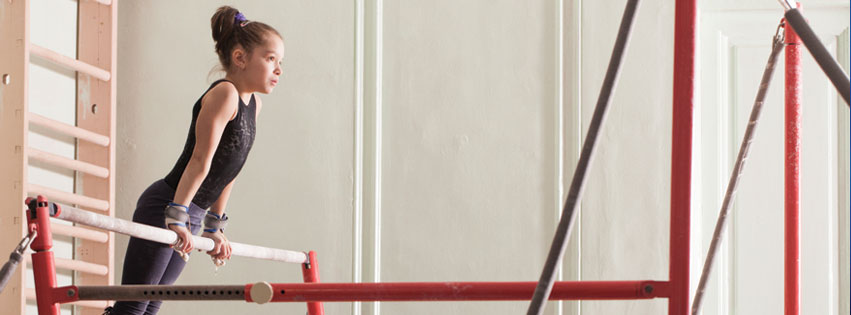The right mix of equipment will help attract the types of students you want at your gym. The equipment your gym needs depends entirely on what events and skills will be taught there and how much space you have and yes, your budget.
Conventional wisdom tells us all that buying the highest quality equipment you can afford is the best way to manage your budget. In fact, the more expensive the equipment (say uneven bars versus foam balls), the more important it is that you buy a piece that’s of high quality and durability. Your investment will minimize future costs in maintenance, replacement, and (heaven forbid) potential damages due to injuries occurring on low quality or poorly maintained equipment.
However, before you can get into what specific brands and models to buy, you should already have a working list of equipment your kids’ gym needs. You need to work out your equipment requirements after you’ve defined your gym’s service and market focus. The scope of services you plan to offer directly determines how much space you need and what sort of equipment is required. You need this information to put together a facility criteria list for your real estate agent, create a startup budget, and model your financial projections.
Measuring revenue or profitability on a square foot basis are fundamental financial metrics for kids’ gyms. The more space you have for equipment, the more students you can enroll — assuming you also have the staff and market to support more and larger classes. However, if your vision is to have a hyper-niched kids’ gym for a small market, then you’ll maximize your potential for profitability per square foot with a smaller space.
Bottom line: The space size and scope of equipment you buy for your kids’ gym must be balanced against the projected size of your market and the class fees your local market will bear.
Equipment lists from blocks to apparatuses
- Thick, high-quality mats, cushions, and support pads. Nothing will go further in protecting your students from injury. This includes a wide variety of wall padding, rollers, inclines, wedges, and the balls and blocks for your foam pit.
- Spotting and training belts and harnesses. As with all the equipment, keep in mind the age and size range of your students, as well as how many trains at a time. You want to make sure you have enough of the right sizes to meet enrollment.
- Trampolines give students a literal boost when they’re learning new moves. They also provide some protection with their side netting, which helps kids find the confidence to make these leaps. You don’t need to get full-sized, backyard trampolines. Gymnastic training trampolines come in a variety of sizes letting you limit the space they take so you can maximize your gym’s overall space.
- Chalk, chalk bowls, and chalk stands. Have extras on hand.
- Chairs and benches for students and parents to use while waiting for equipment to become available.
After this essential gym equipment, you’ll need a variety of apparatus for each event you train. You also need to make sure you have apparatus options on enough varying heights and width to accommodate the range of ages, body sizes, and skill levels you’re training:
- Balance beams
- A collection of bars that can be mix and matched into parallel, uneven, and high bars, depending on who’s training and when. This way, you can minimize space needed and expense on bar equipment.
- A floor space ample enough for a floor exercise mat and its border. The current size as set by the Federation of International Gymnastics is roughly 40 feet by 40 feet, not including the protective border. If you teach girls both rhythmic and artistic floor exercise, you’ll need plenty of ribbons, balls, clubs, and hoops too.
- If you train boys covering the full range of boys’ events, you’ll also need a pommel horse and rings.
- Have extra apparatus anchors on hand so replacements can be installed immediately without endangering students or putting an apparatus out of rotation for too long. As with the apparatus itself, start with the highest quality anchors you can afford. The anchor will reduce the stress put on the apparatus itself, extending its safe, useful life.
Where and how to buy gym equipment
The price range on gymnastic equipment is wide. If you plan on fielding a competitive team or training competitive gymnasts, you need to ensure you’re buying equipment that meets the specifications of relevant competitive bodies (e.g., USAG, NCAA, and NFHS). They will likely be on the higher end.
One way you can keep your equipment costs down is to buy used equipment. There are risks to this approach, but it may be helpful in some instances. First, distinguish between purchasing equipment that’s used because it’s been in someone else’s gym for the past five years and demo equipment from a vendor. Demo equipment from a vendor won’t have the wear and tear of genuinely used equipment. Approach buying used gymnastics equipment as you would buying a used car. Low mileage, clean safety history, and reliable maintenance records are critical.
Another way to save money is to buy floors and equipment unassembled… if you and your team have the expertise to install them correctly. If you don’t have experience installing a gym floor or other equipment, the cost-savings will be short-term only.
You also want to comparison shop and a find a gym equipment vendor with whom you can develop a relationship. Countless websites are selling commercial gym equipment, many of which also have brick and mortar stores. You can consult equipment and vendor reviews to identify the best brands, models, and sources. If you find a vendor or two where you can buy most of your equipment, you’ll be in an excellent position to negotiate more advantageous costs and payment terms.
Keeping costs low doesn’t mean taking shortcuts
Gymnastic moves are risky. Your gym’s equipment needs to be up to the task of supporting your students. Fortunately, you do have options to keep your equipment budget under control. These options also include leasing or financing major kids’ gym apparatuses.
Just keep in mind, your gym’s equipment is a much a part of your service delivery as your staff. While you can find economies when equipping your gym, this isn’t the area to cut corners. Pare down costs to the minimum in other areas, if necessary. Your gym’s equipment should shine.





